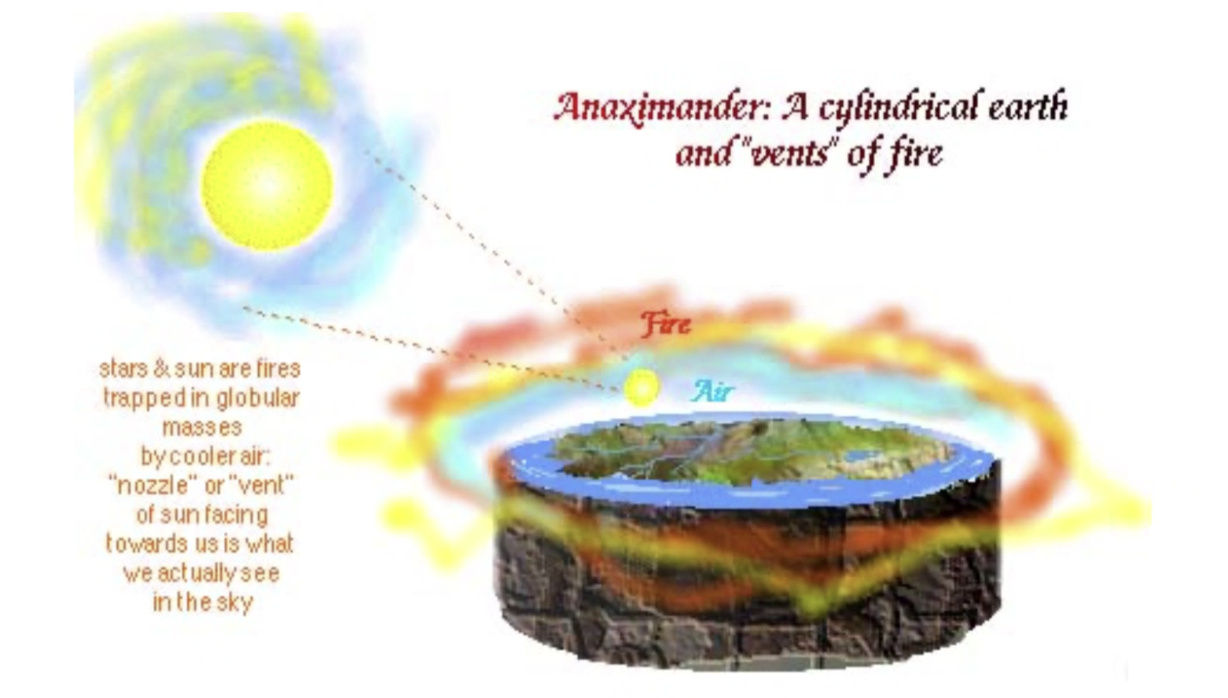Phys Sci WW3
1/36
There's no tags or description
Looks like no tags are added yet.
Name | Mastery | Learn | Test | Matching | Spaced |
|---|
No study sessions yet.
37 Terms
Greek Evidence of a Spherical Earth
Ships Over The Horizon, The Shape of Earth's Shadow on the Moon, Difference in the Night Sky by Location, Eratosthenes' Measurement of Earth's Circumference
The Shape of Earth's Shadow on the Moon
The earth's shadow on the moon is always circular, supporting the concept that Earth is a sphere.
Eratosthenes' Measurement of Earth's Circumference
He measured the sun's angle at two locations to estimate Earth's size using geometry.
Anaximander’s Concept of Aperion
Described Earth as a free-floating cylinder and introduced the concept of infinite or boundless (Aperion) in the universe.

Pythagoras' View on the Cosmos
Believed numbers and geometric relationships governed the cosmos and one of the first who proposed that Earth is spherical.
Plato's Circular Motion Concept
Believed all celestial motions were perfectly circular and encouraged models that matched observations.
Eudoxus' Concentric Spheres Model
Proposed 27 concentric spheres carrying celestial bodies, one of the first mechanical models.
Aristotle's Prime Mover
Adopted Eudoxus' model and proposed the Prime Mover to explain the motion of celestial bodies.
Aristarchus' Heliocentric Model
Famous for propose a heliocentric model with the sun at the center of the universe.
Ptolemaic Model's Epicycles
Introduced the concept of epicycles to explain the retrograde motion of planets within a geocentric framework.
Copernican Revolution
Revived the heliocentric model, explaining retrograde motion more simply by placing the sun at the center.
Tycho Brahe's Hybrid Model
Tycho Brahe's model kept Earth stationary at the center but had other planets orbit the sun.
Galileo's Telescope Improvements
Galileo improved telescope designs, increasing magnification and image quality, leading to significant astronomical discoveries.
Discovery of Lunar Craters
Galileo observed that the moon was not smooth but covered with craters, challenging the belief in perfect celestial bodies.
Phases of Venus
Galileo found that Venus went through phases, providing evidence for the heliocentric model.
Moons of Jupiter
He discovered four moons orbiting Jupiter, showing Earth was not the only center of motion.
Sunspots
Galileo observed spots on the sun that changed, challenging the notion of celestial perfection.
Supernova Observation
He observed a bright new star, providing evidence that celestial bodies can change.
Apparent Size of Stars
Galileo noted stars as distinct points of light at varying distances, challenging the fixed celestial sphere concept.
Tycho Brahe's Systematic Observations
Known for precise astronomical observations and advanced instruments for measuring planetary positions.
Johannes Kepler's Laws
Law of Ellipses, Law of Equal Areas, Law of Harmonies
Law of Ellipses
Planets move in elliptical orbits around the sun. This law challenged the belief in perfect circular orbits, explained the planetary motion more accurately, eliminating the need for epicycles
Law of Equal Area
Planets move faster when closer to the sun (perihelion) and vice versa (aphelion). This law proved that planetary speeds change, explained seasonal changes, refuted Aristotle's idea of uniformity
Law of Harmonies
The square of a planet's orbital period is proportional to the cube of its average distance from the Sun. This law allowed astronomers to predict planetary positions, provided a mathematical relationship between a planet's distance from the Sun and the time it takes to complete 1 orbit, provided a foundation for newton's laws of gravitation
Aristotelian Motion
Introduced Natural and Violent motion
Natural Motion
Objects tend to return to its natural state based on its composition
Violent Motion
A cause if necessary for an object to move
Galilean Motion
Used Falling Object Experiment and Inclined Plane Experiment
Falling Object Experiment
With no air resistance, all objects fall at the same rate
Inclined Plane Experiment
Objects in motion accelerate uniformly and they stay in motion unless acted upon by an external force
Law of Inertia
Object will keep moving unless acted upon by a force
Law of Acceleration
An object is directly proportional to the force applied and inversely proportional to its mass
Law of Action
Every action there is an equal opposite reaction
Acceleration
Change in velocity over time
Velocity
Objects seed up, slow down, and change directions
Kinematics
Branch of physics that studies the possible motion of a body or system of bodies
Why Kinematics?
Newton’s laws explain why motion happens, equations describe how objects move when forces act on them, allows us the predict the velocity and displacement without explicitly calculating force